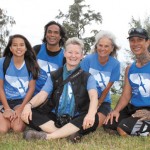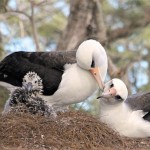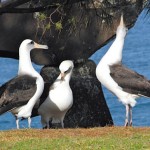Yes We Kan
Kauai’s newest film star made a worldwide debut last month. But don’t worry if you missed catching a glimpse of the fuzzy native Jan. 31, when the hatchling officially broke out of its shell on a Kilauea bluff.
You can watch Niaulani online courtesy of a live-streaming camera from Cornell Lab of Ornithology that is capturing the Laysan albatross chick’s life moment by moment.
- Kauai Albatross Network (Kan) volunteers including (from left) Grace and Paul Ventura, founder Hob Osterlund, Mike Ashley and Stuart Hollinger are committed to Kauai’s Laysan albatross population, utilizing Cornell Lab of Ornithology’s live-streaming camera to observe, protect and teach others about these vulnerable seabirds
- Hob Osterlund enjoys spending her days observing Laysan albatross and teaching others about their behaviors COCO ZICKOS PHOTO
- Laysan albatross consistently demonstrate acts of affection toward one another
- It’s a singles bar dance scene for these Laysan albatross trying to find ‘the one’
- Newborn Niaulani greets the world on Jan. 31 PHOTOS COURTESY HOB OSTERLUND
“Anytime, you can turn it on and see something really fabulous,” says Hob Osterlund, founder of Kauai Albatross Network (KAN), a group instrumental in helping bring these intimate avian moments to the Internet.
Osterlund directs a team of some 20 volunteers who help run and maintain a camera that keeps a constant watchful eye on Niau (named by Oahu kupuna Sam Ohu Gon III). People around the globe can log on to the video anytime, day or night, and see live footage of the plucky chick (gender yet unknown).
“I love them, and I wanted people to see their greatness,” says Osterlund. “Once you’re around them and realize what a rare gift it is, then you can either share it or hoard it.”
The world is lucky she decided to share it, as Kauai is the only place on the planet where people can get so up close and personal with albatross on a regular basis.
“On Kauai, we have an opportunity that no one else has in the world,” she confirms. “The idea being to be a window into the lives of birds.”
Last year, Kaloakulua was the first Laysan albatross chick to become a star through Cornell Lab of Ornithology’s camera (which doesn’t disturb the birds). The young seabird captured people’s hearts from the moment she hatched to the moment she fledged. If all goes well, she will return to her birthplace after spending three to four years at sea.
“The more you get to know them, the more you respect and honor who they are,” says Osterlund. “These birds emulate greatness.”
The video received some 2 million hits from nearly 200 countries last season.
People also were enchanted by the seabird family’s affection for one another. The admiration extended beyond just the parents and their baby — the mother and father always are overjoyed to see each other after returning from their alternating fishing journeys to and from Alaska (a remarkable distance to travel) to get food for their chick.
Albatross typically select a mate for life and are picky about finding “the one.” This is evidenced in the “singles bar” dance scene, which Osterlund points out during a recent interview with Midweek Kauai. The young suitors waddle their way toward the ladies, clacking their beaks while doing the shimmy, eventually hoping to find what they came looking for.
“There are a handful of divorces, but not very often,” jokes Osterlund.
The California native loves to witness these special Laysan albatross moments, and she’s been observing and professionally photographing and writing about them for some 10 years. Her pictures are so captivating, in fact, that they have been picked up by publications such as National Geographic. Her work with her all-volunteer group KAN includes many activities, including monitoring the birds on private properties, and perpetuating awareness about them in as many ways as possible, like holding public presentations.
“We need their ancient wisdom. They’ve been around for millions of years and they know how to coexist with others,” she says.
Laysan albatross vanished from the main Hawaiian Islands after the arrival of humans some 1,000 years ago. They only started returning to Kauai in the 1970s. Their complete vulnerability on a human-populated island is in contrast to Midway, where they are still abundant. This was evidenced last year when several albatross were killed by dogs.
“It was just gut-wrenching,” says Osterlund.
An abandoned hunting dog even approached Kaloakulua at one point on camera last year; the dog sniffed her neck while she was sleeping.
“She didn’t even snap awake. That’s how unaware of predators they are,” says Osterlund. “She didn’t even think it was anything to pay attention to.”
Osterlund has learned so much about albatross behavior since she fell in love with them decades ago while watching birds courting one another in Kilauea.
“I was immediately smitten with them,” she admits.
Her love for wildlife runs in the family. Osterlund is related to the late Martha Beckwith, who penned the famed Hawaiian Mythology. She is following in her ancestor’s footsteps and is working on a book of her own, Holy Moli, about Laysan albatross. Her goal is to write words that are “as beautiful as the birds are.”
Osterlund graduated with a degree in ecological geography from University of California-Berkeley. She is a retired nurse who is a sixth-generation descendant of families that sailed to Hawaii in the 1830s. Her parents moved away from the Islands before she was born, but she eventually found her way back and achieved a master’s degree in nursing from University of Hawaii. She moved to the Garden Isle after landing a job at Wilcox Memorial Hospital.
Now, she devotes all her time to raising awareness about Hawaii’s Laysan albatross. She believes that Kauai is lucky to have elevated bluffs, a lack of predators like mongoose and people who genuinely care about the birds.
“When you have those three together, you can create safe havens for them,” she says.
“They’re really pretty birds,” says Grace Ventura, one of KAN’s youngest volunteers. “If we don’t take care of them, then they’re all going to be gone.”
Mika Ashley-Hollinger is another KAN volunteer who cares about preserving the species.
“They are like ancient mariners,” she says. “They’ve been here for so long and we should be honored to have them here.”
Osterlund agrees that it is an honor to be near Laysan albatross like rising star Niau. She hopes the camera will help others appreciate their beauty as well.
“We just need to find a way to coexist with our fellow creatures in a higher way,” she says. “They know a lot more than we do.”
Visit albatrosskauai.org to watch the video of Niau and another newborn Laysan albatross nearby named Kalai.








